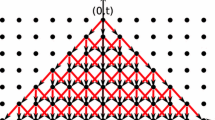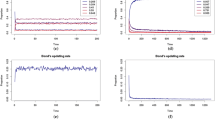Abstract
In dynamical systems, some of the most important questions are related to phase transitions and convergence time. We consider a one-dimensional probabilistic cellular automaton where their components assume two possible states, zero and one, and interact with their two nearest neighbors at each time step. Under the local interaction, if the component is in the same state as its two neighbors, it does not change its state. In the other cases, a component in state zero turns into a one with probability \(\alpha ,\) and a component in state one turns into a zero with probability \(1-\beta \). For certain values of \(\alpha \) and \(\beta \), we show that the process will always converge weakly to \(\delta _{0},\) the measure concentrated on the configuration where all the components are zeros. Moreover, the mean time of this convergence is finite, and we describe an upper bound in this case, which is a linear function of the initial distribution. We also demonstrate an application of our results to the percolation PCA. Finally, we use mean-field approximation and Monte Carlo simulations to show coexistence of three distinct behaviours for some values of parameters \(\alpha \) and \(\beta \).








Similar content being viewed by others
References
Galperin, G.A.: One-dimensional automaton networks with monotonic local interaction. Probl. Inf. Transm. 12(4), 74–87 (1975)
Galperin, G.A.: Homogeneous local monotone operators with memory. Sov. Math. Dokl. 228, 277–280 (1976)
Galperin, G.A.: Rates of interaction in one-dimensional networks. Probl. Inf. Transm. 13(1), 73–81 (1977)
de Menezes, M.L., Toom, A.: A non-linear eroder in presence of one-sided noise. Braz. J. Probab. Stat. 20(1), 1–12 (2006)
de Santana, L.H., Ramos, A.D., Toom, A.: Eroders on a plane with three states at a point. Part I: deterministic. J. Stat. Phys. 159(5), 1175–1195 (2015)
Toom, A.: Contornos, Conjuntos convexos e Autômato Celulares (in Portuguese). \(23^o\) Colóquio Brasileiro de Matemática, IMPA, Rio de Janeiro (2001)
Toom, A.: Stable and attractive trajectories in multicomponent systems. In: Dobrushin, R., Sinai, Y. (eds.) Multicomponent Random Systems. Advances in Probability and Related Topics, Dekker, vol. 6, pp. 549–576 (1980)
Mairesse, J., Marcovici, I.: Around probabilistic cellular automata. Theor. Comput. Sci. 559, 42–72 (2014)
Ponselet, L.: Phase transitions in probabilistic cellular automata. arXiv:1312.3612 (2013)
Petri, N.: Unsolvability of the recognition problem for annihilating iterative networks. Sel. Math. Sov. 6, 354–363 (1987)
Kurdyumov, G.L.: An algorithm-theoretic method for the study of homogeneous random networks. Adv. Probab. 6, 471–504 (1980)
Toom, A., Mityushin, L.: Two results regarding non-computability for univariate cellular automata. Probl. Inf. Transm. 12(2), 135–140 (1976)
Fatès, N.: Directed percolation phenomena in asynchronous elementary cellular automata. In: LNCS Proceedings of 7th International Conference on Cellular Automata for Research and Industry, vol. 4173, pp. 667–675 (2006)
Regnault, D.: Directed percolation arising in stochastic cellular automata. In: Proceedings of MFCS 2008. LNCS, vol. 5162, pp. 563–574 (2008)
Buvel, R.L., Ingerson, T.E.: Structure in asynchronous cellular automata. Physica D 1, 5968 (1984)
Harris, T.E.: Contact interactions on a lattice. Ann. Probab. 2(6), 969–988 (1974)
Liggett, T.M.: Interacting Particle Systems. Springer, Berlin (1985)
Toom, A.L.: A Family of uniform nets of formal neurons. Sov. Math. Dokl. 9(6), 1338–1341 (1968)
Toom, A., Vasilyev, N., Stavskaya, O., Mityushin, L., Kurdyumov, G., Pirogov, S.: Stochastic cellular systems: ergodicity, memory, morphogenesis. In: Dobrushin, R., Kryukov, V., Toom, A. (eds.) Nonlinear Science: Theory and Applications. Manchester University Press, Manchester (1990)
Taggi, L.: Critical probabilities and convergence time of percolation probabilistic cellular automata. J. Stat. Phys. 159(4), 853–892 (2015)
Toom, A.: Ergodicity of cellular automata .Tartu University, Estonia as a part of the graduate program (2013). http://math.ut.ee/emsdk/intensiivkursused/TOOM-TARTU-3.pdf
Norris, J.R.: Markov Chains. Cambridge University Press, Cambridge (1997)
Ramos, A.D., Toom, A.: Chaos and Monte-Carlo approximations of the Flip-Annihilation process. J. Stat. Phys. 133(4), 761–771 (2008)
Fatès, N., Thierry, É., Morvan, M., Schabanel, N.: Fully asynchronous behavior of double-quiescent elementary cellular automata. Theor. Comput. Sci. 362, 1–16 (2006)
Słowiński, P., MacKay, R.S.: Phase diagrams of majority voter probabilistic cellular automata. J. Stat. Phys. 159, 4361 (2015)
Taati, S.: Restricted density classification in one dimension. In: Proceedings of AUTOMATA-2015. LNCS 9099, pp. 238–250. Springer, Berlin (2015)
Acknowledgements
The authors would like to thank the anonymous reviewers for their valuable comments and suggestions, which certainly improved the presentation and quality of the paper.
Author information
Authors and Affiliations
Corresponding author
Appendix
Appendix
1.1 Transitions of \((i_t,j_t)\) and Process X
Now, we will study the random variables \(i_t\) and \(j_t\) (see Fig. 2), starting by its probabilities transition. Let \(a,~b,~c,~d\in \mathbb N\). We denote by
On \(\mathbb P((a,b-1)|(a,b))\) and \(\mathbb P((a+1,b)|(a,b)),\) we do not indicate what happened when \(b=a+2,\) because in this case just on the position \(a+1\) we get the component on state 1 and in all the other components the state is 0. Moreover, in this case \(\{(a, b-1)| (a, b)\}= \{(a+1, b)|(a, b)\},\) hence we reach the configuration “all zeros” and \(\mathbb P((a+1,b)|(a,b))=\mathbb P(R_1\cap L_1).\)
For \(\mathbb P((a,b-1)|(a,b)),~\mathbb P((a+1,b)|(a,b))\) (resp. \(\mathbb P((a+1,b+1)|(a,b)),~\mathbb P((a-1,b-1)|(a,b))\) ) if \(b> a+2\) (resp. \(b=a+2\)) then \(j_t-i_t-1\) describes the length of the island of ones which with non-null probability can: increase by one, increase by two, decrease by one, decrease by two, or stay the same.
Now, we define process X :
where \(c=b-a-1\). Thus, we concluded the task to define the process X associated to G.
1.2 Proof of Lemmas 7 and 8
Proof of lemma 7
Item (a) results directly from the difference equation (10). Now, let us prove item (b); before we do that, several observations need to be established:
-
(1)
If \(\alpha \in (0,1)\) and \(\beta \le \phi (\alpha ),\) then \(\gamma _1\ge 1\). Moreover, \(\gamma _1= 1\) when \(\beta = \phi (\alpha ).\)
-
(2)
If \(\alpha \in (0,1/3],\) then \(\gamma _2< -1.\)
-
(3)
If \(\alpha \in (1/3,1)\) and \(\beta \ge (\alpha -1)/(3\alpha -1),\) then \(\gamma _2\le -1\). Moreover, \(\gamma _2=-1\) when \(\beta = (\alpha -1)/(3\alpha -1).\)
As \((\alpha -1)/(3\alpha -1)\) is negative for \(\alpha \in (1/3,1)\) and \(\beta \) is non-negative, we can conclude that if \(\alpha \in (1/3,1),\) then \(\gamma _2< -1.\) Thus, (2) and (3) can be concatenated in the following way:
(2’) if \(\alpha \in (0,1)\) then \(\gamma _2< -1.\)
Let us consider the case \(\beta =\phi (\alpha )\). So, \(\gamma _1=1,\) which implies that \(h_i=1+C_2((\gamma _2)^{i}-1).\) But in that case, \(\gamma _2<-1\). Thus, we get \(|h_i|\rightarrow \infty \). However, \(h_i\in [0,1]\) for all \(i\in \mathbb N\) which will be satisfied just for \(C_2=0.\)
From (1) and (2’), if \(\alpha \in (0,1)\) and \(\beta < \phi (\alpha ),\) then
\(C_1\) and \(C_2\) can not have the same sign. Because if \(C_1\) and \(C_2\) are both positive(respectively both are negative), then using the limit (19) \(C_1((\gamma _1)^{2i}-1)\) and \(C_2((\gamma _2)^{2i}-1)\) goes to infinity (respectively \(-\infty \)) when \(i\rightarrow \infty .\) So \(h_{2i}\rightarrow \infty \) (respectively \(-\infty \)) with \(i\rightarrow \infty \). But \(h_i\in [0,1]\) for all \(i\in \mathbb N\), what will be satisfied only for \(C_1=C_2=0.\)
\(C_1\) and \(C_2\) can not have different signals. Because if \(C_1>0\) and \(C_2<0\)(respectively \(C_1<0\) and \(C_2>0\)), then using the limit (19) \(C_1((\gamma _1)^{2i-1}-1)\) and \(C_2((\gamma _2)^{2i-1}-1)\) goes to infinity (respectively \(-\infty \)) when \(i\rightarrow \infty .\) So \(h_{2i-1}\rightarrow \infty \) with \(i\rightarrow \infty \) but \(h_i\in [0,1]\) for all \(i\in \mathbb N\), what will be satisfied just for \(C_1=C_2=0.\)
The case when \(C_1=0\) and \(C_2\) is different from zero (respectively \(C_2=0\) and \(C_2\not =0\)) is trivial. \(\square \)
Lemma 9
Given real values \(C_1,~C_2,~a\) and b where \(b<-a\le -1\):
-
(a)
If \(C_1\) and \(C_2\) are negative, then \(C_1 a^{2i}+C_2 b^{2i}\le C_1a^{2i}.\)
-
(b)
If \(C_1<0\) and \(C_2>0,\) then \(C_1 a^{2i-1}+C_2 b^{2i-1}\le C_1 a^{2i-1}.\)
-
(c)
If \(C_1\) and \(C_2\) are positive, then
$$\begin{aligned} C_1 a^{2i-1}+C_2 b^{2i-1}\rightarrow -\infty \hbox { and } \frac{2i-1}{C_1 a^{2i-1}+C_2 b^{2i-1}}\rightarrow 0\hbox { when }i\rightarrow \infty . \end{aligned}$$ -
(d)
If \(C_1>0\) and \(C_2<0,\) then
$$\begin{aligned} C_1 a^{2i}+C_2 b^{2i}\rightarrow -\infty \hbox { and } \frac{2i}{C_1 a^{2i}+C_2 b^{2i}}\rightarrow 0\hbox { when }i\rightarrow \infty . \end{aligned}$$
Proof
Items (a) and (b) are trivial. The case \(a=1\) is trivial; therefore, we shall consider when \(a>1.\) Next, let us prove item (c). Note that if \(1<-b/a,\) then \((-b/a)^{2i-1}\rightarrow \infty \) when \(i\rightarrow \infty .\) Also, \(a^{2i-1}\rightarrow \infty \) when \(i\rightarrow \infty .\) So, for each negative M value, there is a natural value \(i_M\) such that \(i>i_M\) implies that
Thus, \({C_1a^{2i-1}}<M-C_2b^{2i-1}.\) We proved the first part of item (c). Now, let us prove the second part. For this task, it is sufficient to prove
This is what we shall do. We get \((-b/a)^{2i-1}\rightarrow \infty \) and \(a^{2i-1}\rightarrow \infty \) when \(i\rightarrow \infty .\) So, for given M value, \(M(2i-1)/a^{2i-1}\rightarrow 0\) when \(i\rightarrow \infty .\) Therefore, for each negative M value, there is a natural value \(i_M,\) such that \(i>i_M\) implying that
Thus, \(C_1a^{2i-1}<M(2i-1)-C_2b^{2i-1}.\) Item (c) is proved. \(\square \)
Let us prove item (d). Note that \(1<b^2/a^2,\) then \((b/a)^{2i}\rightarrow \infty \) when \(i\rightarrow \infty .\) Also, \(a^{2i}\rightarrow \infty \) when \(i\rightarrow \infty .\) So, for each negative M value, there is a natural value \(i_M\) such that \(i>i_M,\) implying that
Thus, \({C_1a^{2i}}<M-C_2b^{2i}.\) We have now finished the first part of item (d). Now, let us prove the second part, which essentially proves that
Once \(b<-a\le -1,\) we get that for each negative M value there is natural value \(i_M\) such that \(i>i_M,\) implying that
Thus, \(C_1a^{2i}<M(2i)-C_2b^{2i-1}.\)
Proof of Lemma 8
Item (a) results directly from the difference equation (11). Here, we need to observe: (4) if \(\alpha ,\beta \in (0,1),\) then \(-1\ge -\gamma _1>\gamma _2 .\)
If we consider \(C_1\) and \(C_2\) negative, then by Lemma 9 item (a), we get
Moreover,
i.e., there is \(i_0\) such that \(i>i_0,\) implying that \(k_{2i}^Y<0\) is impossible. Then, \(C_1\) and \(C_2\) can not be simultaneously negative.
If we consider \(C_1<0\) and \(C_2>0,\) then by Lemma 9 item (b), we get
Moreover
i.e., there is \(i_0\) such that \(i>i_0,\) implying that \(k_{2i-1}^Y<0\) is impossible. So, the case \(C_1<0\) and \(C_2>0\) is impossible.
If we consider \(C_1=0\) and \(C_2\not =0,\) then for \(C_2>0,~\) \(C_2(\gamma _2)^{2i-1}\rightarrow -\infty \) when \(i\rightarrow \infty \) and for \(C_2<0,~\) \(C_2(\gamma _2)^{2i}\rightarrow -\infty \) when \(i\rightarrow \infty \). In both cases, there is \(i_0\) such that \(i>i_0,\) implying that \(k_{2i-1}^Y<0\) in the first case or \(k_{2i}^Y<0\) in the second case. Both cases are impossible. Then, the case \(C_1=0\) and \(C_2\not =0\) is impossible.
If we consider \(C_2=0\) and \(C_1<0,\) then \(C_1(\gamma _1)^{i}\rightarrow -\infty \) when \(i\rightarrow \infty .\) So, there is \(i_0\) such that \(i>i_0\) implying that \(k_i^Y<0\) is impossible. Then, the case \(C_2=0\) and \(C_1<0\) is impossible.
If we consider \(C_1\) and \(C_2\) positive, then by Lemma 9 item (c) we conclude that
Thus, there is \(i_0\) such that \(i>i_0,\) implying that \(k_{2i-1}^Y<0\) is impossible. Then, the case of \(C_1\) and \(C_2\) being positive is impossible.
Analogously to the previous case, \(C_1\) and \(C_2\) positive, if we consider \(C_1>0\) and \(C_2<0,\) then by Lemma 9 item (d) we conclude that there is \(i_0\) such that \(i>i_0,\) implies that \(k_{2i}^Y<0\) is impossible. Then, the case \(C_1>0\) and \(C_2<0\) is impossible.
Until this point, we proved that \(C_2=0\) and \(C_1\ge 0.\) Thus,
However, we get \((\gamma _1)^i>1\Rightarrow C_1((\gamma _1)^i-1))\ge 0\Rightarrow k_i^Y\ge i/\eta > 0\) when \(\beta < \phi (\alpha )\). By theorem 1.3.5 in [22], the mean hitting time is the minimal non-negative solution to system (11). This happens in our case when \(C_1=0.\) \(\square \)
Rights and permissions
About this article
Cite this article
Ramos, A.D., Leite, A. Convergence Time and Phase Transition in a Non-monotonic Family of Probabilistic Cellular Automata. J Stat Phys 168, 573–594 (2017). https://doi.org/10.1007/s10955-017-1821-z
Received:
Accepted:
Published:
Issue Date:
DOI: https://doi.org/10.1007/s10955-017-1821-z




